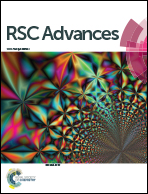Preparation of alternating multilayered polyethylene oxide/poly(ε-caprolactone) and the confined crystallization of the composites
Abstract
In this paper, polyethylene oxide (PEO) and poly(ε-caprolactone) (PCL) were co-extruded to form alternating multilayered structures with different layer numbers. For a given film thickness, the layers were thinner as the layer numbers became higher, and more interfaces were observed. The crystallization behaviors of these two polymers varied distinguishably as the layer number became higher. For the crystallization of PEO, the molten PCL layers promoted the crystallization rate of PEO, while the spatial confinement of the layer thickness significantly suppressed the crystallization rate of PEO at higher layer numbers. In the case of PCL layers, the effect of spatial confinement on the crystallization of PCL was negligible due to the small crystal size of PCL, while the interfacial interaction between PEO and PCL layers suppressed the crystallization rate of PCL at the layer interfaces. Meanwhile, the degree of crystallinity (Xc) of PEO decreased from 70.2% to 40.0% when the layer number increased from 2 to 128, while the Xc of PCL did not vary much.


 Please wait while we load your content...
Please wait while we load your content...